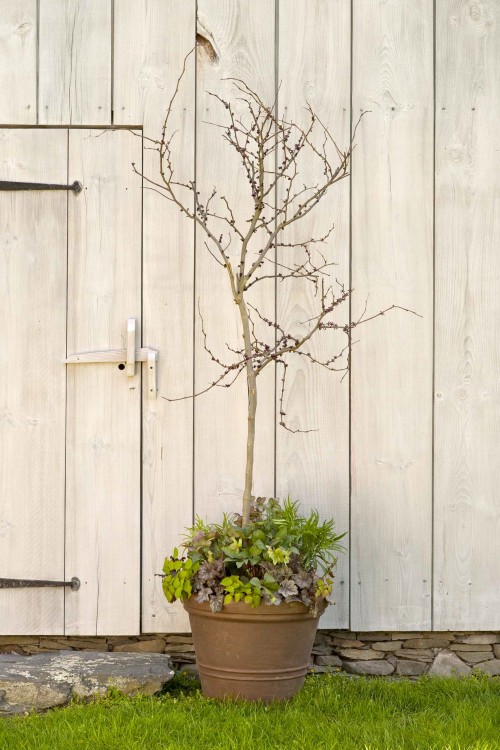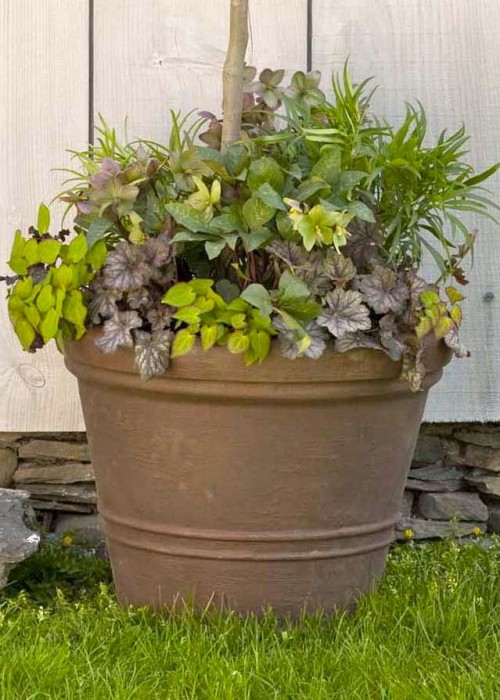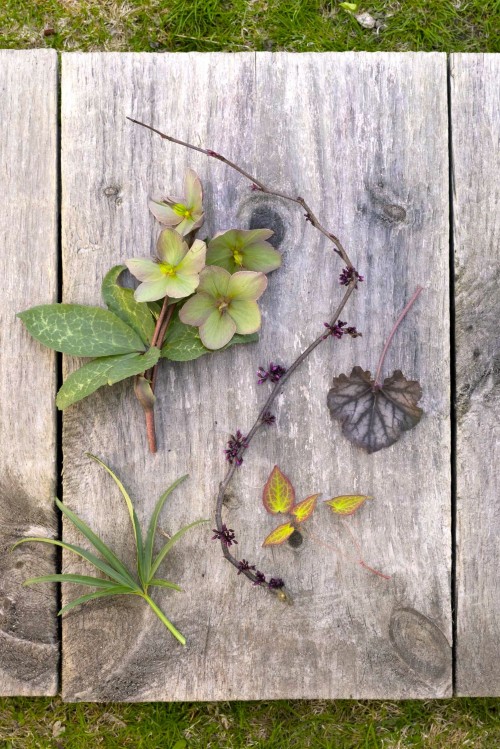
I have been thinking about a little woodland patch right outside my living room window. Last year, I planted hellebores and sweet little epimediums and now I just want more. This year I will plant my spring containers with a composition similar to this cercis planting and then plan to move the plants to my hellebore cutting garden later in the fall.
In it, hellebores sit alongside purple leaved heuchera, epimedium, and beneath a beautiful cercis tree that will produce bright pink blossoms on bare branches before leafing out into a beautiful native new England understory tree.

When the hellebores have overstayed their welcome, they will transition to that sweet garden nook where I can snip selections for early spring bouquets.

I love this gorgeous hand tied grouping of hellebore and pieris from Marigold & Mint.
If you are looking for planting ideas for the very early spring cutting garden – Pierus (as knows as Andromeda) is an easy shrub that blooms early and makes for a great combination to the nodding blooms of a collection of hellebores.
-Roanne

(Images: John Gruen and Marigold and Mint)
How to Plant Hellbores
1. Choose the Right Location:
Select a shaded or partially shaded location in your garden that mimics the natural habitat of hellebores. Ideally, the area should receive dappled sunlight or morning sun and afternoon shade. Hellebores thrive in fertile, well-draining soil, enriched with organic matter.
2. Prepare the Soil:
Before planting, prepare the soil by loosening it with a fork and incorporating compost or well-rotted manure. Hellebores prefer a slightly alkaline soil (which is commonly found in a natural woodland garden setting), but you can amend it with lime if necessary.
3. Select Varieties of Hellebores that are good for cutting:
Choose hellebore varieties that are well-suited for cutting and have a long blooming season. Look for varieties with sturdy stems and outward-facing flowers, as these are ideal for cut arrangements. Popular cutting hellebore species include Helleborus niger, Helleborus orientalis, and Helleborus hybridus.
4. Plan the Layout:
Design the cutting garden with a naturalistic feel, emulating the woodland setting. Arrange the hellebores in small clusters or drifts, leaving ample space for them to spread and naturalize over time. Consider incorporating other shade-loving plants like ferns, hostas, and woodland bulbs to add diversity and interest.
5. Planting Hellebores:
Plant the hellebores in early spring or autumn when the soil is still moist and temperatures are mild. Dig holes slightly larger than the root ball of each plant, and space them about 1 to 2 feet apart, depending on the mature size of the hellebore variety. Water thoroughly after planting to ensure good establishment.
6. Mulching and Watering:
Apply a layer of organic mulch around the hellebores to retain soil moisture and suppress weed growth. Keep the soil consistently moist but not waterlogged, especially during dry periods. Hellebores appreciate regular watering, especially when they are establishing their root systems.
7. Deadheading and Hellebore Cutting:
To promote continuous blooming, deadhead spent flowers by removing the old flower stems at their base. As hellebores have a long flowering season, you’ll have ample opportunities to cut flowers for indoor arrangements. When cutting hellebores, choose stems with fully mature flowers and use sharp, clean scissors or pruners to make clean cuts.
If you cut your hellebores before they are ripe, the vase life will be significantly shorter. Ripe hellebores have dropped their stamens (you can see them at the center of the flower). Once the stamens drop, the seed pods begin to develop – the longer you wait (and the more developed the pod) – the longer the cut hellebore flowers will last in the vase. and
8. Hellebore Propagation:
As the hellebores naturalize and expand over the years, you can propagate them by division. In early spring or autumn, carefully lift the clumps and divide them into smaller sections, ensuring each division has a good amount of roots. Replant the divided hellebores in the cutting garden or share them with fellow gardening enthusiasts.
9. Hellebore Seasonal Care:
In late winter (right after the snow melts), I remove any old and tattered foliage to make way for fresh spring growth. I apply a fresh layer of 50/50 compost mulch in early spring to encourage healthy growth and abundant flowering.
+comments+